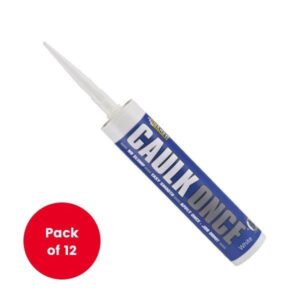Decorators Caulk Sealant
Caulk sealant for decorators is a liquid-based sealant and flexible filler, normally used to repair cracks and gaps on door frames and windows. Learn more [ FAQ ]
Showing the single result
Decorators Caulk FAQs
What is decorators caulk?
Caulk is a type of flexible acrylic mastic filler commonly used by decorators to fill in cracks or gaps between surfaces (e.g. between walls and doorframes, walls and skirting boards or around ceilings). Once decorators caulk is applied, the surface is ready to be painted or otherwise decorated.
Incredibly versatile as a filler, decorators caulk is cheap and easy to apply using a caulking gun, with no need for other accessories. The caulk dries within hours into a tough elastic rubber seal and remains flexible even after it’s finished drying.
The main downside of the smooth plastic texture of decorators caulk is that, unlike powder filler, it cannot be rubbed down, meaning it’s very obvious when used to fill more central holes in the wall.
What is decorators caulk used for?
The flexibility of decorators caulk makes it the perfect material for filling cracks, as it can absorb a certain degree of movement and keep the area looking great. Commonly, this type of caulk is used for cracks in the corners of walls, gaps around skirting boards, window and door frames, and ceiling coving.
Decorators caulk is sometimes even considered superior to more traditional powder fillers which tend to form cracks upon any movement. This type of caulk also dries much faster and can be easily smoothed using a finger, often without need of sanding.
The flexibility of decorators caulk makes it especially well-suited for window and door frames, because it can contract or expand to absorb any changes in size caused by weather fluctuations. In comparison, gaps along the edge of skirting boards or around door frames can easily crack if they’ve been filled with a traditional powder filler.
How to use decorators caulk?
Decorators caulk is often used as a flexible filler between two materials prone to forming cracks. Usually, cracks appear between non flexible materials (e.g. masonry or plaster) and flexible materials (e.g. wood).
Before you go ahead with using decorators caulk, make sure the cracks you’re going to fill are clean of dirt and other debris. You should also check the instructions on the caulk packaging to find out whether it requires the area to be dry for application.
If you choose to apply the caulk using the cartridge method, you will need a silicone (also knowns as mastic) gun for the application. For best results, run the decorators caulk along the crack, making sure you don’t use too much, then run a wet finger over the caulk line to smooth.
Using a fingertip to smooth out surfaces after the application of decorators caulks is often considered neater than using actual tools. Depending on the type of caulk, you can wet your fingertip with water (latex caulk) or baby oil (silicone caulk).
Can decorators caulk be painted?
Many decorators’ caulks come in a choice of colours and can be painted over to fit your decorating requirements once the cracks have been filled. Everbuild Caulk Once, for instance, is fast-drying and permanently flexible and can be over painted in an hour with all paint types or covered over with wallpaper.
Once dried, most decorators caulk can be painted over – the surface usually needs about an hour. If you spot any cracks in the filling after you’ve painted with emulsion, apply an oil-based undercoat to the caulk and re-emulsion when dry.
Some types of silicone decorators caulks are designed to dry underneath paint. You can decorate such paintable caulks with spray paint immediately after application, or apply oil-based paint with a paint brush not long after. Make sure that the surface paint has dried completely before exposing the silicone caulk to moisture.
If you don’t want to paint some of the surfaces, try masking instead to protect them.
Can decorators caulk be used externally?
Contrary to the common perception of flexible fillers as purely internal products, decorators caulk comes in both internal and external grades. Silicone caulk in particular is great for filling cracks in outdoor areas exposed to the elements. The silicone will extend the longevity of the caulk, sealing the gaps against water or air damage.
Window units are a great example of external applications for decorators caulk. A silicone caulk can be used around the outside of a window to seal it properly, while allowing the sliding edge a degree of flexibility.
The Everbuild Everflex 195 Siliconised Acrylic Sealant product, for instance, is a siliconised acrylic sealant, suitable for internal and external use, which provides a permanently flexible long lasting seal and adheres to virtually all materials. Compared to conventional acrylic sealants, Everflex 195 has improved adhesion characteristics and contains a powerful fungicide to prevent mould growth.
Is decorators caulk waterproof?
Decorators caulk is vulnerable to moisture before it’s cured completely, so we recommend applying it in dry weather (if used outdoors) or waiting a couple of hours before subjecting its surface to water (if used in a bathroom).
If you are using caulk to fill gaps in areas that will be subjected to water often, such as baths, kitchens, windows or doors, make sure you select a decorators’ caulk that’s permanently waterproof. Applying non waterproof caulk in these areas can lead to water damage and the growth of mould.
Check the manufacturer’s instructions to make sure the decorator’s caulk you’ve chosen is waterproof. As a rule, latex caulks don’t perform well when consistently exposed to water, whether that’s under a shower door or at the corners of an aquarium. This unsuitability for confined areas is due to the fact that latex caulks require plenty of air exposure to cure.
By contrast, the curing process of silicone caulks is chemical-based and therefore less reliant on air. This makes products such as Everbuild Everflex 125 One Hour Caulk perfect for filling gaps between non-absorbent surfaces and allows them to shine in areas with high water exposure.
Can decorators caulk be removed by sanding?
While caulk is very flexible and easy to smooth before drying, once it’s cured it can be quite difficult to fix or remove. If you are using ready-mix paste or powder caulk, you may be able to sand it by working at the bumps carefully with fine sandpaper. However, if you are working with decorators cork (the type packaged in a cartridge) sanding it might not be an option.
You might be able to use a utility knife to take off any large chunks of dried decorators caulk that are making the surface uneven, but overall we recommend not letting the caulk cure before you’ve smoothed it. Fixing small imperfections while the caulk is moist is easy – running a damp sponge or a finger over it will often be enough to create a polished surface.
What is the difference between decorators caulk and silicone?
Caulk is a rigid sealant (when dry) which makes it better suited to sealing gaps in areas with minimal movement (contraction and expansion).
Silicone sealants remain flexible which make them ideal for areas that are prone to expansion and contraction.
Both have issues with being rubbed down, but generally decorators caulk may be slightly easier to manipulate when dry.
| Caulk | Silicone |
|---|---|
| Caulk is a sealant used to seal construction cracks | Silicone is a type of sealant used mainly to bind surfaces such as ceramic, metal, glass or plastic. |
| It is less prone to movement than silicone | It can be used in rooms with a higher moisture level |
| Caulk dries quicker than silicone and it shows good resistance to weathering | Silicone has strong binding properties that can be applied to almost any surface |
| It cannot be used is areas that are prone to expansion and contraction | It is ideal for areas that are prone to expansion and contraction |
| Paint can be applied over caulk | Paint can't be applied over silicone |
| Ideally used to seal the corners between walls and cracks between walls and ceilings | Ideally used to seal junctions between the tiles, baths, sinks, bathroom fittings, etc. |
Can decorators caulk be used as an adhesive?
Sometimes. Put simply, the flexibility of polyurethane, latex and silicone caulks allows them hold together materials exposed to minimal amounts of movement, much in the same way as a waterproof adhesive would.
That said, since decorators caulk is not a real glue product, its adhesive properties will deteriorate much quicker than those of an actual adhesive. The bond will grow weaker over time, especially if it’s exposed to extreme weather conditions such as cold, heat or moisture.

